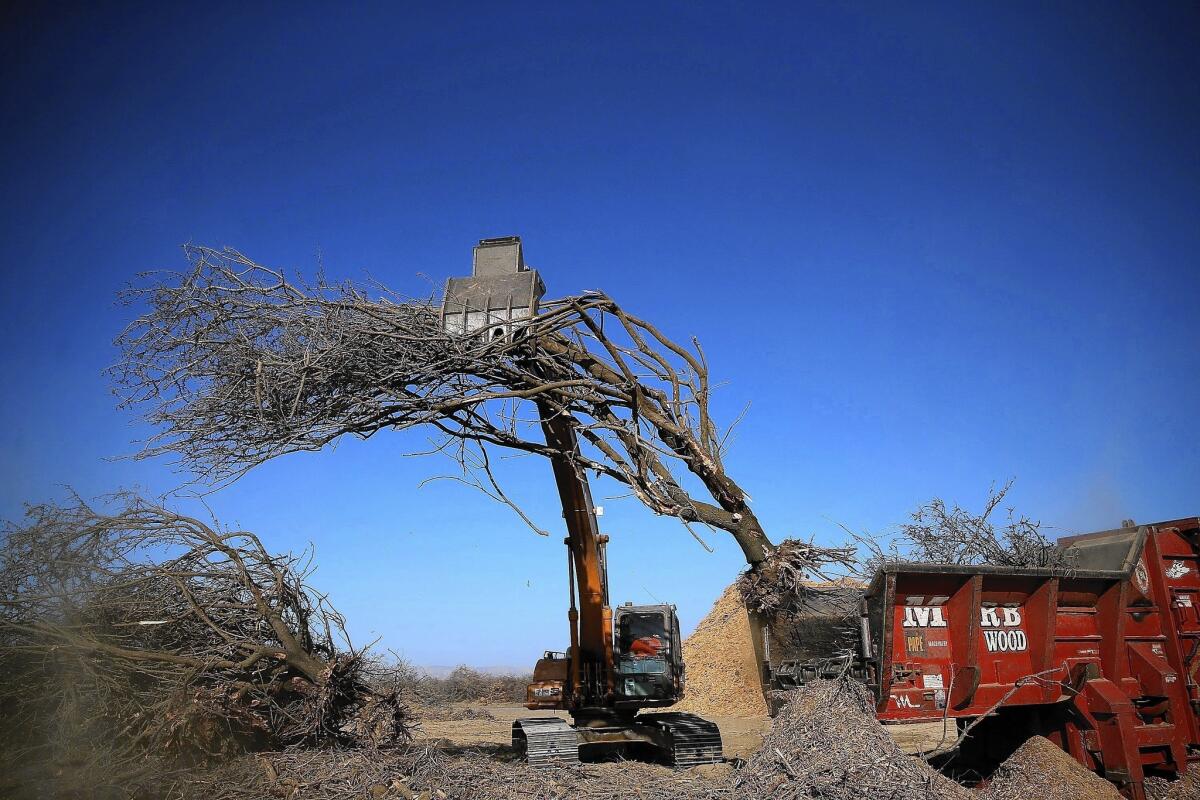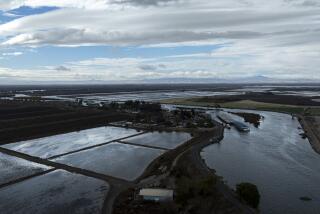Column: Water fight pits farmer against farmer

SACRAMENTO — Forget farmers vs. fishermen — or south state vs. north state. California’s current water war is being waged most intensely by farmers against fellow farmers.
It’s a Central Valley civil war. And within that vast food-producing region — Bakersfield to Redding — it’s the San Joaquin Valley vs. the Sacramento-San Joaquin Delta.
Southern California is a paying participant, siding with the San Joaquin, but in a less combative role. Its goal is to ensure a more reliable flow of delta water over the Tehachapi. Still unanswered, however, is how much more that would cost Southland ratepayers.
The San Joaquin — especially the Westside I-5 corridor — has the political power in this fight. The weaker delta has the water and thus, one could argue, the moral high ground.
Both sides are desperate. San Joaquin growers feel they need a steadier flow of delta agriculture water to survive — not just this scary drought, but long term into the next generation.
Delta farmers say that would leave them defenseless against crop-killing salt water from San Francisco Bay.
“Drain the Delta,” of course, is not the battle cry heard from the San Joaquin. It’s “Snuff the Smelt.”
The smelt is an obscure finger-size fish so innocuous it isn’t even used for bait. But it’s endangered and entitled to federal protection. It gets chomped by giant pumps pushing delta water into the California aqueduct for valley farms and Southland cities. So courts have restricted pumping.
“Yes, we are in a drought,” says Gayle Holman, public affairs representative for the huge Westlands Water District that provides irrigation for roughly 600,000 acres in Fresno and Kings counties. “But we didn’t get here through nature alone. We also got here through environmental regulations that limited the amount of water sent to [nearby] San Luis Reservoir.”
Government agencies, she continues, “felt that the water needed to be kept in the delta for protection of the smelt. So consequently the water flowed out under the Golden Gate Bridge. Agriculture keeps having to provide additional water for a fish species with no discernible benefit.”
That’s one side.
Chinook salmon also are threatened by delta pumping. Roughly 90% of California’s salmon, which nourishes a coastal fishing industry, are produced in the delta and its tributaries. Courts have protected that majestic creature too.
As for the lowly smelt, it’s considered a canary in the coal mine for delta water and agriculture, an indicator of biological health.
Smelt require fresh water — as do crops — and young salmon need strong flows to flush them out to sea. Pumping, especially during a drought, sucks fresh water from the delta, hurting fish and farms.
“If the water’s not fresh enough for the smelt, it’s not fresh enough for crops in the delta,” says Jonas Minton, a former deputy director of the state water department and now a policy advisor for the Planning and Conservation League. “If it’s good for fish, it’s good for farms. That’s the symbiotic relationship.”
The immediate fight is over access to delta water during the drought. San Joaquin fields are being fallowed for lack of water.
“We’re anticipating that [Westlands] growers will take 200,000 acres out of production,” Holman says. “That’s a huge hit — approximately 300 square miles.” Last year, she says, crops were grown on 560,000 acres.
Fallowed crops include tomatoes, melons, onions, broccoli and lettuce. And 1,100 acres of older almond trees have been chopped down to save the water for younger orchards.
For the first time, both the state and federal water projects are talking about delivering no water for irrigation south of the delta this year. That would leave only the options of over-pumping aquifers, buying expensive water from private parties or not planting.
They’re also planting less in the delta, which trumps the San Joaquin Valley in water rights but still is suffering from low Sierra runoff.
“We’re seeing salt water,” says Wendy Buckley-Stokes, a fourth-generation delta farmer who grows wine grapes, cherries, apples, alfalfa and corn. She may pass on planting her usual 500 acres of corn this summer, hurting four local dairies.
But the big battle is over Gov. Jerry Brown’s ambitious plan to bore two 40-foot wide, 35-mile long tunnels under the delta to siphon off the estuary’s freshest water from the Sacramento River just south of the capital city. There are few smelt there.
That has delta pear, asparagus and tomato farmers up in arms fighting alongside Buckley-Stokes. In their view, much of the San Joaquin’s west side farming is unsustainable in the long run because of toxic soil contaminated with selenium, boron and salts.
“I don’t think we should sacrifice sustainable [delta] agriculture for non-sustainable agriculture,” Buckley-Stokes says. “And that’s what they’re trying to do.”
Holman dismisses such talk. “Our yield speaks for itself,” she says. “We continue to produce. We grow 60 different crops here — usually over $1 billion in value.”
But for how long? And at what price to delta farmers?
About $250 million has been spent so far by Westlands, other entities and the Metropolitan Water District, which services much of Southern California, to finance government planning of the tunnels. That’s ratepayers’ money. More big bills will be due shortly.
Construction cost is pegged at $15 billion — double that including interest, all paid by water users.
Westlands must decide by fall whether to drop another $560 million for planning, with no guarantee yet of stable flows. MWD will be handed a similar tab.
“Our recommendation is that they grow a new crop there — electrons,” conservationist Minton says of Westlands. “It would be a great place for solar.”
Different subject maybe. But maybe a good idea.
More to Read
Start your day right
Sign up for Essential California for news, features and recommendations from the L.A. Times and beyond in your inbox six days a week.
You may occasionally receive promotional content from the Los Angeles Times.







